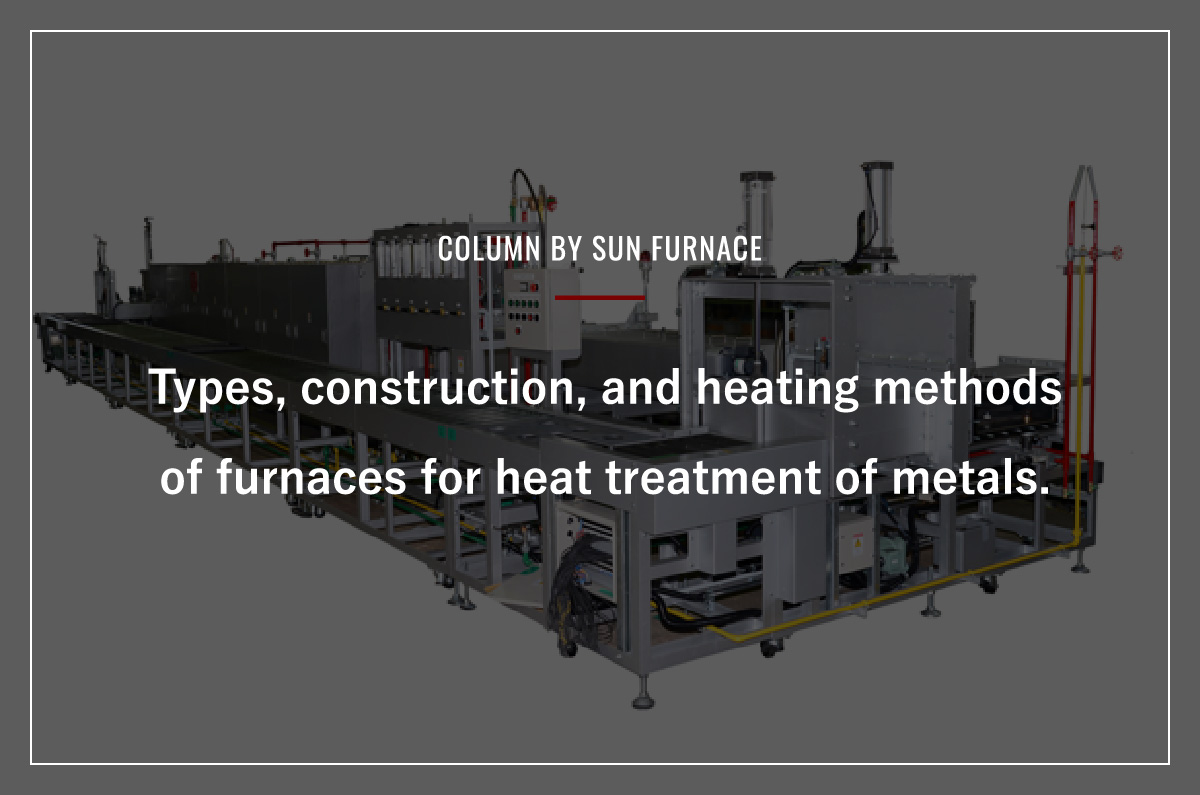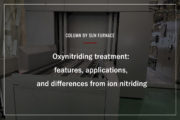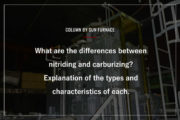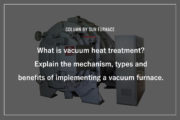We have designed and manufactured over 1500 industrial furnaces, catering to various industries such as automotive, steel, and chemical. With extensive experience and a proven track record in a wide range of furnace types, we offer a diverse range of solutions. In addition to industrial furnaces, we provide total support for related equipment and conveyors, and have successfully tackled a multitude of challenges based on different specifications and needs.
Types, construction, and heating methods of furnaces for heat treatment of metals.

The furnace is a device used in various industries to perform “heat treatment,” which brings out the properties of metals such as iron and steel. By subjecting metals to heat treatment, their hardness and toughness can be changed, making it possible to give them the desired properties for their intended use. Representative heat treatments include “quenching,” “tempering,” “annealing,” and “normalizing.”
For example, in the automotive industry, heat treatment is used to give many parts such as engine components, steering systems, transmissions, brakes, and suspensions the necessary wear resistance and fatigue resistance. This technology is essential not only for the automotive industry but also for the development of Japan’s core industries, such as the machinery industry, and has supported the quality of Japanese manufacturing.
In this article, we will explain in detail the structure, characteristics, and types of furnaces, which are important production equipment for realizing such heat treatment technology.
目次
What is a heating furnace?
A heating furnace is an industrial furnace that can control the temperature of heated materials, such as iron, based on heat treatment conditions such as heating conditions, holding temperature, and cooling conditions.
By processing metals in a heating furnace according to the necessary heat treatment conditions, necessary properties such as hardness and toughness can be achieved.
Heating furnaces have two main functions: heating and cooling. The heating function is composed of the heating method and atmosphere gas, while the cooling function is composed of the cooling method and cooling material.
Heating furnaces are widely used in Japan’s key industries, such as the automotive and machinery industries, and heat-treated parts account for about 80% of these industries’ products.
In Japan, heat treatment is a highly specialized field, and many manufacturers that provide subcontracted processing are involved in the intermediate process, processing raw materials such as steel and non-ferrous metals, and industrial machinery manufacturers that process finished products.
Structure of a heating furnace
Today, we will provide an overview of the common components found in different types of industrial furnaces, including heating furnaces. While the specific structures may differ depending on the classification, there are some key elements that are typically present in most heating furnaces. Let’s take a closer look.
Types of heating furnaces
The type of furnace is selected based on the size of the heated material and the heat treatment method.
There are two main types of furnaces.
- Batch furnace
Batch furnace – a type of heating furnace that uses a conveying device to load and unload products. The heated objects are stacked in baskets or trays and managed for their residence time within the furnace before being transported by the conveying device. The batch furnace is suitable for producing a variety of small quantities of products. - Continuous furnace
Continuous furnace – a type of heating furnace that continuously conveys products through the heating chamber using a mesh belt or tray pusher. The continuous furnace is suitable for producing large quantities of a single type of product.
Heating source equipment
In heating furnaces, heaters are mainly used for electric types, and burners are used for combustion heating types.
Energy sources such as electricity, gas (city gas, propane, LNG), heavy oil, and kerosene are used to increase the ambient temperature inside the furnace.
The required output of the heat source device is calculated based on the heat generated by the object being heated, the heat radiated from the surface of the equipment, the heat lost when opening and closing the door, and the required heating speed.
Designing with too much capacity increases the cost, while designing with insufficient capacity can lead to production stoppages when output drops due to unexpected issues.
Heating chamber
We heat the chamber and raise it to a certain temperature to thermally process the object to be heated.
To prevent temperature irregularities within the chamber, the air is circulated with fans.
If the fans fail for any reason, all products being heated will become defective, resulting in significant losses.
Installing a rotation sensor is thus one way to immediately identify issues. A particular substance known as insulation material is used to insulate the surrounding space since heat loss from the heating chamber raises fuel and energy expenditures. Refractory bricks, which were frequently utilized in the past, have given way to lighter insulation materials with superior insulation capabilities.
When choosing insulation materials, cost-effectiveness and equipment safety must be taken into account because some insulation materials with superior performance can be more expensive.
Atmosphere gas
An atmospheric gas is the gas used to replace the air in a heating furnace for a specific purpose.
- Inert gases:Nitrogen and argon
Prevent reactions with heated materials. - Oxidizing gases:Oxygen and water vapor
Create oxide layers on the surface of steel materials by inducing decarburization reactions. - Reducing gases:Hydrogen, ammonia, and decomposition gases
Used for bright heat treatment to prevent high-temperature oxidation and maintain a shiny surface of steel materials. - Carbonizing gases:Carbon monoxide, Hydrocarbon gas, Natural gas, Propane gas, and Methanol
Used for carburizing treatment on the surface of steel materials.
Special gases may also be used for nitriding treatment and other special applications.
Examining Sun Furnace’s atmosphere gas generator in detail
Cooling equipment
Heating furnaces often incorporate cooling functions, and there are various types of cooling agents such as water, oil, and air.
The transportation method for the cooling device depends on the processing capacity. For high-capacity processing, a continuous method is used where the products are automatically transported from the heating furnace using a conveyor belt, and then sent into the cooling device where they are cooled by a cooling medium.
Types and characteristics of heating furnaces
Now, we will explain the types and features of heating furnaces.
Electric furnace
Types and features
Electric furnaces are often used for heat treatment where precise temperature control is critical due to their ability to achieve high precision temperature control. There are two types of heating methods: direct heating by conduction, convection, and radiation, and indirect heating. Compared to combustion furnaces, electric furnaces are more capable of precise temperature control.
Heating methods
There are several types of heating methods, including:
- Resistance heating
Resistance heaters such as metal heaters, silicon carbide (SiC), molybdenum, tungsten, and carbon are commonly used.
Temperature control is achieved by inserting a thermocouple into the heater and managing the heater temperature, thereby controlling the temperature inside the furnace. - Induction heating
This is the most widely used method of electric heating.
A high-frequency magnetic field is created by an external coil, inducing an electric current in the object to be heated, and heating the surface of the object. It is an efficient method. - Electron beam heating
This is a heating method that irradiates an electron beam onto the object to be heated to partially generate high temperature. - Laser beam heating
Similar to electron beam heating, this method irradiates the object to be heated with a laser beam to partially generate high temperature. - Direct current heating
This is a heating method in which electric current is passed directly through the object to be heated, generating self-heating, and is also known as “Joule heating”.
Corresponding to the characteristics of each heating method, almost all heat treatments such as quenching, tempering, nitriding, carburizing quenching, and bright heat treatment can be performed.
Combustion furnace
Types and features
Combustion furnaces use liquid or gas fuel to heat products.
Kerosene or heavy oil are utilized as liquid fuels, whereas natural gas, propane gas, and liquefied natural gas are used as gas fuels.
There are two types of heating methods: direct heating, which involves directly applying the flame of a combustion burner, and indirect heating, which uses radiant tubes or muffles to heat the product.
Direct heating is often used for annealing of cast iron and cast steel.
Burner equipment
A burner is a device that burns fuel such as gas or oil to increase the temperature inside the heating chamber.
There are also regenerative burners that lessen dangerous pollutants like NOx and high-efficiency oxygen burners that use only the minimal amount of oxygen for burning.
Safety regulations have been tightened for furnaces that employ burners for heating, including the installation of flame detectors to catch burner misfires and gas detectors to catch gas buildup inside the furnace to prevent explosions.
Classification of heating furnaces by cooling method
After being processed in a heating furnace, the heated material is then cooled under controlled temperatures according to the heat treatment conditions.
Depending on the various cooling material employed, there are several sorts of cooling processes.
Air cooling
Air cooling is the most straightforward technique but has the least cooling capacity.
When natural cooling is not enough, forced cooling via a fan may be used.
It is possible to carry out hardening by air chilling alone for materials with good hardenability.
Water cooling
Water cooling has the greatest cooling capacity and includes direct and indirect cooling. Direct cooling can result in poor quality if liquid temperature control is difficult or if stirring is insufficient.
Oil cooling
Three types of mineral oil for quenching oil are specified in [JIS K 2242]
- Type 1: For general quenching
- Type 2: For hot bath quenching
- Type 3: For tempering
Other methods
There are cooling methods using water-soluble coolant of polymer compounds and nitrate-based salt baths.
These have intermediate cooling capacity between water and oil, and require attention to concentration and temperature control.
Common questions about heating furnaces
In this section, we will address some common questions about heat treatment furnaces.
Q: What are the methods for inspecting heat-treated products?
To ensure that the final product has the desired properties, various inspections are conducted since the appearance of the finished product does not reveal whether the product has the intended properties.
These inspections include destructive tests and material tests such as hardness testing, microstructure analysis, visual inspection, and non-destructive testing.
- Destructive testing
This involves breaking the test piece under specified conditions and measuring its strength. - Hardness testing
This involves pressing a punch onto the test piece and measuring the indentation shape to determine the hardness. - Microstructure analysis
This involves collecting test pieces from the heat-treated product, polishing and etching them, and observing the microstructure using a microscope. - Measurement and visual inspection
This involves measuring the dimensions and deformation of the heat-treated product and inspecting for surface defects. - Non-destructive testing
This involves using X-rays, ultrasonic waves, or other methods to inspect the internal cracks or inclusions in the heat-treated product.
Q: How are furnace temperature and control methods measured?
There are two main methods for measuring furnace temperature: contact and non-contact. The selection depends on factors such as the temperature range and material being measured, as well as the surrounding environment.
One of the most commonly used methods is thermocouples.
They work by joining two types of metal wires to generate a thermoelectric power that corresponds to the temperature difference between the two wire ends.
For heating furnaces, K-type thermocouples (usable up to 1000℃) and R-type thermocouples (usable up to 1400℃) are often used.
As for temperature control, basic on-off control is the simplest and cheapest method, but more precise PID control has become more prevalent.
Dedicated temperature controllers are integrated into the furnace control panel and the output of the heater is PID-controlled through a regulator called a thyristor.
Modern temperature controllers often come with an auto-tuning function, allowing for parameter settings without the need for detailed manual adjustment.
Q: How Can You Determine the Life Span of a Heating Furnace?
As a heating furnace ages, the insulation material can degrade, causing an increase in heat radiation from the equipment surface, and the drive components, such as the doors, can deform due to the heat, creating gaps in the body, which in turn leads to increased heat radiation.
In such a condition, energy loss becomes significant, and electricity and fuel costs increase, affecting the product cost.
Once the costs exceed a certain threshold, replacing the equipment becomes cost-effective.
To determine the optimal timing for replacing the equipment, a system to monitor the furnace’s degradation should be in place, such as periodically checking the power consumption to identify signs of aging.
Summary
We have explained the structure, types, and heating methods of heating furnaces.
A heating furnace is composed of a conveying device, heating device, heating chamber, cooling device, and other components, and the configuration can vary depending on the heat treatment method and processing capacity required.
Heating furnaces are broadly divided into electric furnaces and combustion furnaces, with electric furnaces offering the advantage of easy temperature control and maintenance. Combustion furnaces, on the other hand, are used for processing large quantities in larger furnaces but can present safety issues such as harmful exhaust gases and explosions.
Since heating furnaces are often used in combination with cooling devices, it is necessary to choose a cooling method that is suitable for the heat treatment conditions.
At Sun Furnace, a producer of industrial furnaces, we offer specialized heating furnaces that are catered to your demands utilizing our experience gained from building more than 1,500 industrial furnaces.
We also offer technical consultations, so please feel free to contact us.
Check our product lineup



